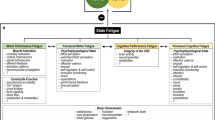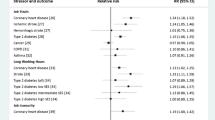Abstract
The heart rate and systolic and diastolic blood pressures (HR, BPs, and BPd, respectively) were measured in controllers of electricity distribution at the beginning and end of 12-h shifts. Hemodynamic parameters were calculated. The stress was assessed with a five-point scale. It was found that the stress of mental work of the operator type activated the functioning of the cardiovascular system (CVS). The CVS reaction was more pronounced and interactive during the first shifts in each block than during the second shifts. The CVS reaction was more pronounced and interactive during day shifts than during night shifts. An increase in stress during the first day shifts was accompanied by a decrease in HR and an increase in minimum BPd during the shift, in the absence of a BPs reaction. The minimum levels of all three parameters (HR, BPs, and BPd) were increased during the first night shifts, which indicates that the effectiveness of CVS activation in the nighttime was decreased as compared to the daytime. The BPd is specifically sensitive to the work stress of controllers: its reaction to an increase in stress is classic during the first shifts and inverted during the second night shifts. This reflects exhaustion of adaptation reserves. The HR showed attenuated reactivity during the daytime, but not during the nighttime, when it reacted in the classic way.
Similar content being viewed by others
References
Selye, H., The stress concept as it is understood in 1976, in Novoe o gormonah i mekhanizme ikh deistiya (News about Hormones and Mechanism of their Action), Kiev: Naukova Dumka, 1977, pp. 27–51.
Baevskii, R. M., Kirillov, O.I., and Kletskin, S.Z., Matematicheskii analiz serdechnogo ritma pri stresse (Mathematical Analysis of Heart Rhythm during Stress), Moscow: Nauka, 1984.
Sokolov, E.I. and Belova E.V., Emotsii i patologii serdtsa (Emotions and Heart Pathologies), Moscow: Nauka, 1983.
Hjortskov, N., Rissen, D., Blangsted, A.K., et al., The Effect of Mental Stress on Heart Rate Variability and Blood Pressure during Computer Work, Eur. J. Appl. Physiol., 2004, vol. 92, nos. 1–2, pp. 84–89.
Becker, L.C., Pepine C.J., Bonsall, R., et al., Left Ventricular, Peripheral Vascular, and Neurohumoral Reactions to Mental Stress in Normal Middle-aged Men and Women. Reference Group for the Psychophysiological Investigations of Myocardial Ischemia (PIMI) Study, Circulation, 1996, vol. 94, no. 11, pp. 2768–2777.
Finsen, I., Sogaard, K., Jensen C., et al., Muscle Activity and Cardiovascular Reaction during Computer-mouse Work with and without Memory Demands, Ergonomics, 2001, vol. 44, no. 14, pp. 1312–1329.
Schoder, H., Silverman, D.H., Campisi, R., et al., Regulation of Myocardial Blood Flow Reaction to Mental Stress in Healthy Individuals, Am. J. Physiol. Heart Circ. Physiol., 2000, vol. 278, no. 2, pp. H360–366.
Schoder, H., Silverman, D.H., Campisi, R., et al., Effect of Mental Stress on Myocardial Blood Flow and Vasomotion in Patients with Coronary Artery Disease, J. Nucl. Med., 2000, vol. 41, no. 1, pp. 11–16.
Steptoe, A., Evans, O., and Fieldman, G., Perceptions of Control over Work: Psychophysiological Reactions to Self-paced and Externally-paced Tasks in an Adult Population Sample, Int. J. Psychophysiol., 1997, vol. 25, no. 3, pp. 211–220.
Hoffman, R. and Al’Absi, M., The Effect of Acute Stress on Subsequent Neurophychological Test Performance, Arch. Clin. Neuropsychol., 2003, vol. 19, no. 4, pp. 497–506.
Rau, R., Job Strain or Healthy Work: a Question of Task Design, J. Occup. Health. Psychol., 2004, vol. 9, no. 4, pp. 322–338.
Ohsuga, M., Shimono, F., and Genno, H., Assessment of Phasic Work Stress Using Autonomic Indices, Int. J. Psychophysiol., 2001, vol. 40, no. 3, pp. 211–220.
Kelsey, R.M., Soderlund, K., and Arthur, C.M., Cardiovascular Reactivity and Adaptation to Recurrent Psychological Stress: Replication and Extension, Psychophysiology, 2004, vol. 41, no. 6, pp. 924–934.
Steptoe, A., Roy, M.P., Evans, O., and Snashall, D., Cardiovascular Stress Reactivity and Job Strain as Determinants of Ambulatory Blood Pressure at Work, J. Hypertens., 1995, vol. 13, no. 2, pp. 201–210.
Kageyama, T., Nishikido, N., Kobayashi, T., et al., Long Commuting Time, Extensive Overtime, and Sympathodominant State Assessed in Terms of Short-term Heart Rate Variability among Male White-collar Workers in the Tokyo Megalopolis, Ind. Health., 1998, vol. 36, no. 3, pp. 209–217.
Sato, S., Taoda, K., Kawamura, M., et al., Heart Rate Variability during Long Truck Driving Work, J. Hum. Ergol., 2001, vol. 30, nos. 1–2, pp. 235–40.
Holmes, A.L., Burgess, H.J., McCulloch, K., et al., Daytime Cardiac Autonomic Activity during One Week of Continuous Night Shift, J. Hum. Ergol., 2001, vol. 30, nos. 1–2, pp. 223–228.
Iskra-Golec, I., Fafrowicz, M., Marek, T., et al., The Effect of a Change in Sleep-Wakefulness Timing, Bright Light and Physical Exercise Interventions on 24-h Patterns of Performance, Mood and Body Temperature, J. Hum. Ergol., 2001, vol. 30, nos. 1–2, pp. 261–266.
Spurgeon, A., Harrington, J.M., and Cooper, C.L., Health and Safety Problems Associated with Long Working Hours: a Review of the Current Position, Occup. Environ. Med., 1997, vol. 54, pp. 367–375.
Knutsson, A., Health Disorders of Shift Workers, Occup. Med., 2003, vol. 53, pp. 103–108.
Navakatikyan, A.O. and Kryzhanovskaya V.V., Vozrastnaya rabotosposobnost’ lits umstvennogo truda (Age Dependence of Mental Working Capacity), Kiev: Zdorov’ya, 1979.
Arinchin, N.I. and Kulago, G.V., Gipertonicheskaya bolezn’ kak narushenie samoregulyactsii krovoobrashcheniya (Hypertension as Disruption of Self-Regulation of Blood Circulation), Minsk: Nauka i Tekhika, 1969.
Khramov, Yu.A. and Veber, V.R., Vegetativnoe obespechenie i gemodinamika pri gipertonicheskoi bolezni (Autonomic Mechanisms and Hemodynamics during Hypertension), Novosibirsk: Nauka, 1985.
Bobko, N.A., The Functioning of the Cardiovascular System in Controllers of Electric Networks during 12-hour Shifts, Fiziol. Zh., 2001, vol. 47, no. 5, pp. 82–86.
Selye H., The Story of the Adaptation Syndrome, Montreal: Acta, 1952.
Author information
Authors and Affiliations
Additional information
Original Russian Text © N.A. Bobko, 2007, published in Fiziologiya Cheloveka, 2007, Vol. 33, No. 3, pp. 55–62.
Rights and permissions
About this article
Cite this article
Bobko, N.A. Effect of stress on the cardiovascular system activity in operators of predominantly mental work at different times of the day and the working week. Hum Physiol 33, 302–308 (2007). https://doi.org/10.1134/S0362119707030073
Received:
Issue Date:
DOI: https://doi.org/10.1134/S0362119707030073




